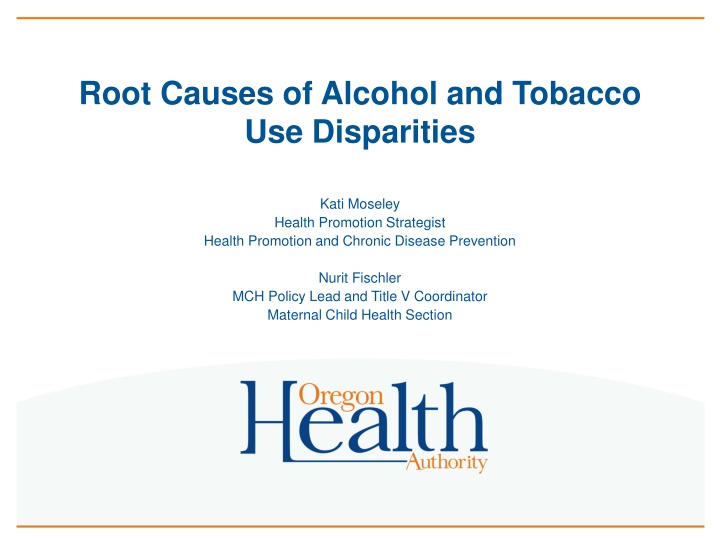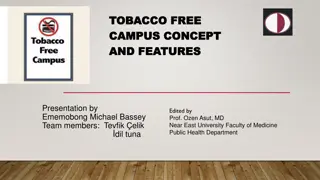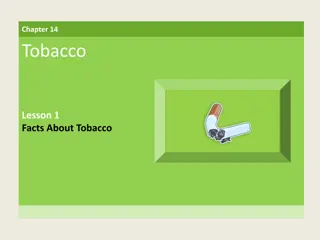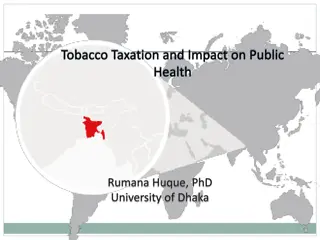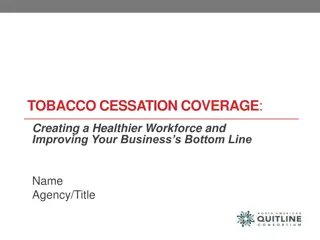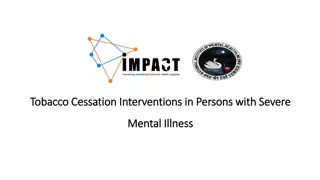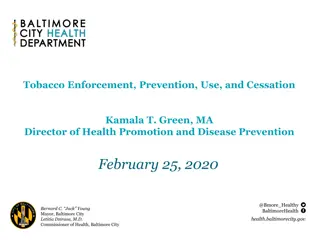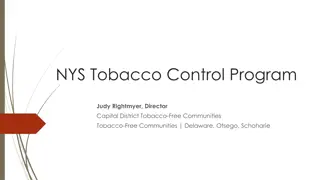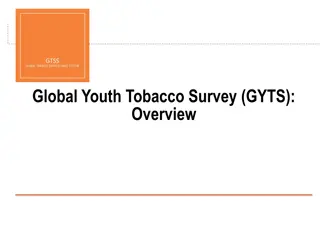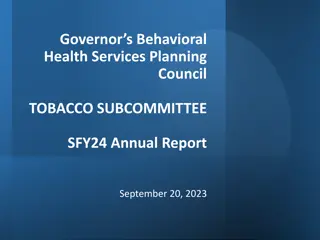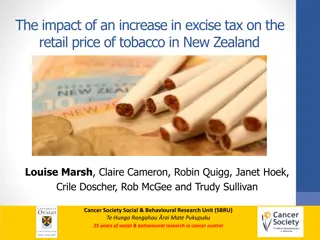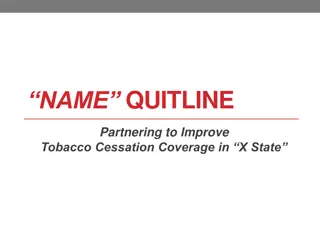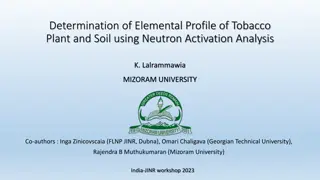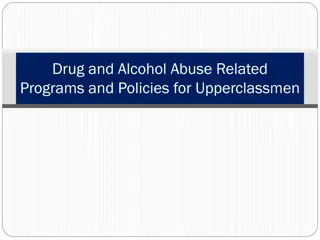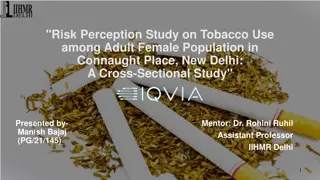Root Causes of Alcohol and Tobacco Disparities
Exploring the complex factors influencing alcohol and tobacco use discrepancies, this content delves into the socio-ecological framework, trauma’s impact, Oregonian data, and structural determinants affecting health equity and public health policies.
Download Presentation

Please find below an Image/Link to download the presentation.
The content on the website is provided AS IS for your information and personal use only. It may not be sold, licensed, or shared on other websites without obtaining consent from the author.If you encounter any issues during the download, it is possible that the publisher has removed the file from their server.
You are allowed to download the files provided on this website for personal or commercial use, subject to the condition that they are used lawfully. All files are the property of their respective owners.
The content on the website is provided AS IS for your information and personal use only. It may not be sold, licensed, or shared on other websites without obtaining consent from the author.
E N D
Presentation Transcript
Root Causes of Alcohol and Tobacco Use Disparities Kati Moseley Health Promotion Strategist Health Promotion and Chronic Disease Prevention Nurit Fischler MCH Policy Lead and Title V Coordinator Maternal Child Health Section
What well cover Socio-ecological Framework A brief on the social determinants of health Trauma, toxic stress and resilience Data What s happening to Oregonians? Frieden s Pyramid Conclusion Public Health Division Health Promotion & Chronic Disease Prevention 2
Socio-Ecological Model PUBLIC POLICY national, state, local laws COMMUNITY relationships among organizations ORGANIZATIONAL organizations, social institutions INTERPERSONAL family, friends, social networks INDIVIDUAL knowledge, attitudes, skills Public Health Division Health Promotion & Chronic Disease Prevention
Framework for Action on Root Causes IMPACT ON HEALTH EQUITY STRUCTURAL INTERMEDIARY DETERMINANTS OF HEALTH DETERMINANTS OF HEALTH INEQUITIES SOCIOECONOMIC AND POLITICAL CONTEXT Socioeconomic Position Governance Social Class Gender Sexual Orientation Disability status Ethnicity, Race Individual and Community Material Circumstances Macroeconomic Policies Behaviors and Biological Factors Public Policies education Psychological Factors Dominant Culture and Societal Values occupation income Health System Social Cohesion/Social Capital
Public Health Division Health Promotion & Chronic Disease Prevention 5
What is Trauma? An event, series of events, or set of circumstances that is experienced by an individual as physically or emotionally harmful or life threatening and that has lasting adverse effects on the individual's functioning and mental, physical, social, emotional, or spiritual well-being. - SAHMSA Can be single event. More often multiple events, over time (complex, prolonged trauma). Interpersonal violence or violation, especially at the hands of an authority or trust figure, is especially damaging. Event, Experience, Effect (SAMHSA) Including experiences systemic oppression & targeted violence (eg. ableism, ageism, racism, sexism, classism)
Adverse childhood experiences and other forms of trauma (historic and personal) are common.
Why Now? Why is it Important? Enormous advances in neurobiology in the last two decades, understanding how toxic stress impacts the architecture of the developing brain. Adverse Childhood Experiences Study (Kaiser & CDC) Link with mental, behavioral, and physical outcomes Compelling evidence for a public health perspective Trauma affects brain function - cognitive and social/behavioral, decision-making, etc. Trauma affects how people approach societal institutions and services. Societal institutions and service systems have often been activating or re-traumatizing.
The Science Neurobiology Epigenetics Adverse childhood experiences Resilience
Research on the biology of stress illustrates how threat raises heart rate, blood pressure, and stress hormone levels, which can: - impair brain architecture, - immune status, - metabolic systems, and - cardiovascular function. Harvard University Center on the Developing Child
Adverse childhood experiences Links adversities in childhood to adult health http://www.acesconnection.com/blog/adding-layers-to-the-aces-pyramid-what-do-you-think
Key components of resilience for individuals Capability: Self-regulation, self- efficacy and perceived control, intellectual and employable skills; social/emotional competence in children Attachment and belonging: Strong adult/child relationship; social connections/positive relationships with friends, supportive adults Connection to Community: Culture, spirituality 1. 2. 3.
Key components of resilience for communities Equitable opportunity: living wages, quality education, local wealth 1. People: connected to community and each other; strong, healthy relationships and community norms 2. Place: safe, supportive environment safe parks and open spaces, cultural expression, access to healthy foods, quality housing, transportation, etc. 3.
Public health approach to trauma Work upstream to prevent adversity and trauma (e.g. family friendly policies) Develop trauma informed systems and services to assure equitable access and avoid re- traumatization Promote resilience in communities, individuals, and families (community capacity and family protective factors)
Adverse Childhood Experiences (ACEs) Childhood experiences of physical, emotional, or sexual abuse and household dysfunction are associated with a myriad of diseases and high risk behaviors in adulthood. Source: https://www.cdc.gov/violenceprevention/acestudy/ace_brfss.html
Number of ACEs among adults, Oregon, 2015 44% of Oregonians experienced 2 or more ACEs during childhood; 22% experience 4 or more. Data source: Behavioral Risk Factor Surveillance System
Prevalence of ACEs types among adults in Oregon, 2015 50% 40% 36.3% 33.6% 31.3% 30% 25.7% 24.3% 20.4% 20% 15.1% 9.3% 10% 0% Emotional Abuse Physical Abuse Sexual Abuse Intimate Partner Violence Household Substance Abuse Household Mental Illness Parental Separation or Divorce Incarcerated Household Member Abuse Household challenges Data source: 2015 Behavioral Risk Factor Surveillance System
Adults in Oregon with high ACEs score (4+) 37.0% 34.8% 31.7% 29.4% 27.0% 25.2% 21.6% 21.4% 19.8% 19.7% 18.6% 17.4% 16.8% 8.3% 2.2% Data source: 2013 2015 Behavioral Risk Factor Surveillance System
Flourishing and ACEs (US Children Age 6-17) 60% 55.4% 46.3% 38.7% 40% 29.5% Flourishing (based on factors possible for parents to observe): 1. Motivation: Curious and interested in learning new things 2. Resilience: Stays calm and in control when faced with a challenge 3. Attention: Follows through and finishes tasks 20% 0% None of 9 ACEs 1 ACE 2-3 ACEs 4+ ACEs Source: Bethell, C 2016
Adverse Childhood Experiences and Adult High Risk Behaviors Adults in Oregon with 4 or more ACEs are: 2.0 times as likely to drink heavily 1.7 times as likely to binge drink 15.6% 7.7% 12.5% 10.5% 4.8% 9.2% 3.9% 3.8% 0 1 2 to 3 4+ 0 1 2 to 3 4+ Number of ACEs Number of ACEs 3.4 times as likely to Smoke cigarettes 28.5% 18.9% 11.2% 8.4% 0 1 2 to 3 4+ Number of ACEs Data source: 2013 2015 Behavioral Risk Factor Surveillance System
Public Health Division Health Promotion & Chronic Disease Prevention 22
Risk Factors and Race/Ethnicity Sources: Student Wellness Survey, (2016)
Cigarette smoking among adults Source: 2010-2011 Oregon BRFSS Race Oversample 35% 33% 21% 21% 14% American Indian or Alaska Native Asian or Pacific Islander Black or African American Latino White
Factors that Affect Health Examples Smallest Impact Condoms, eat healthy, be physically active Counseling & Education Rx for high blood pressure, high cholesterol Clinical Interventions Long-lasting Protective Interventions Immunizations, brief intervention, cessation treatment, colorectal cancer screening Changing the Context to make individuals default decisions healthy Fluoridation, 0g trans fat, iodization, smoke-free laws, tobacco tax Largest Impact Socioeconomic Factors Poverty, education, housing, racism Source: Dr. Tomas R. Frieden, Director, U.S. Centers for Disease Control & Prevention
Framework for Action on Root Causes Emerging PH Practice Current PH Practice IMPACT ON HEALTH EQUITY STRUCTURAL INTERMEDIARY DETERMINANTS OF HEALTH DETERMINANTS OF HEALTH INEQUITIES SOCIOECONOMIC AND POLITICAL CONTEXT Socioeconomic Position Governance Social Class Gender Sexual Orientation Disability status Ethnicity, Race Individual and Community Material Circumstances Macroeconomic Policies Behaviors and Biological Factors Public Policies education Psychological Factors Dominant Culture and Societal Values occupation income Health System Social Cohesion/Social Capital
Want to connect? Kati Moseley Health Promotion Strategist Health Promotion and Chronic Disease Prevention Section 971-673-1002 Katarina.Moseley@dhsoha.state.or.us Nurit Fischler MCH Policy Lead and Title V Coordinator Maternal Child Health Section 971-673-0344 Nurit.R.Fischler@dhsoha.state.or.us Public Health Division Health Promotion & Chronic Disease Prevention 28
